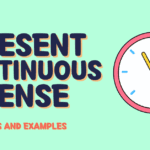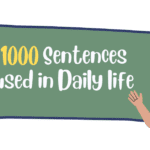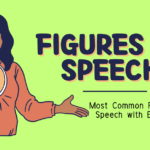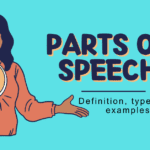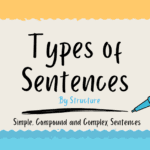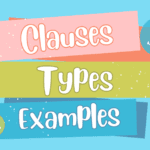In English grammar, the voice of a verb describes the relationship between the action or state described by the verb and the subject of the sentence. There are two main voices in English: the active voice and the passive voice. For example:
Active: The cat chased the mouse.
Passive: The mouse was chased by the cat.
One of the main differences between the active and passive voices is the focus of the sentence.
Here’s what you will learn in this guide:
Active Voice
The active voice refers to a sentence construction where the subject of the sentence is performing the action described by the verb. For example:
- The cat chased the mouse.
In the above sentence, the subject of the sentence is “the cat,” and the verb is “chased.” The sentence is written in the active voice because the cat is the one doing the chasing.
Passive Voice
On the other hand, the passive voice refers to a sentence construction where the subject of the sentence is being acted upon by the verb. For example:
- The mouse was chased by the cat.
In the above example, the subject of the sentence is “the mouse,” and the verb is “was chased.” The sentence is written in the passive voice because the mouse is the one being chased, rather than doing the chasing.
Active and Passive Voice Rules in English Grammar
Here’re certain rules that you need to follow to form passive of any active voice sentence.
Rule 1. To form a passive sentence in English, you need to use the auxiliary verb “to be” (be, am, is, are, was, were, being, been), the past participle (3rd form) of the main verb preceded by (By, With, to, etc).
The subject of the sentence becomes the object of the verb, and the object of the verb becomes the subject of the sentence.
General Structural Formula:
Examples:
- Active: The teacher graded the exams.
- Passive: The exams were graded by the teacher.
- Active: The chef cooks the meal.
- Passive: The meal is cooked by the chef.
Note
The auxiliary verb “to be” should agree with the subject in tense and number.
For example:
- Present tense: The cat is chased by the mouse.
- Past tense: The cat was chased by the mouse.
- Present perfect: The cat has been chased by the mouse.
- Past perfect: The cat had been chased by the mouse.
Rule 2. In the passive voice, the subject of the verb becomes the object of the sentence. Therefore, you should use the object pronouns (me, him, her, us, them) instead of the subject pronouns (I, he, she, we, they).
Examples:
- Active: I love pizza.
- Passive: Pizza is loved by me.
- Active: He writes the letter.
- Passive: The letter is written by him.
Rule 3. If the active sentence includes an object pronoun (me, him, her, us, them), the pronoun will change to the subject pronoun (I, he, she, we, they) in the passive sentence.
Examples:
- Active: She gave me the book.
- Passive: I was given the book by her.
- Active: They offered him the job.
- Passive: He was offered the job by them.
Rule 4. If the active sentence includes an indirect object pronoun (me, him, her, us, them), the pronoun will change to the direct object pronoun (me, him, her, us, them) in the passive sentence.
Examples:
- Active: She gave the book to me.
- Passive: The book was given to me by her.
- Active: They offered the job to him.
- Passive: The job was offered to him by them.
In the above active sentence, “She gave the book to me.”, “the book” is a direct object and ” to me” is an indirect object. When we convert this sentence into passive voice, the indirect object will become a direct object. In the passive sentence “The book was given to me by her.”, you can see “to me” became a direct object, and “by her” is treated as an indirect object.
Rule 5. If the active sentence includes a possessive pronoun (mine, his, her, our, their), it will stay the same in the passive sentence or usually drop in the passive sentence.
Examples:
- Active: He finished his homework.
- Passive: His homework was finished by him. |OR| The homework was finished by him.
- Active: They shared their food.
- Passive: Their food was shared by them. |OR| The food was shared by them.
Rule 6. In the passive voice, the subject of the verb (also known as the agent) is often omitted if it is not necessary for the meaning of the sentence. Here is an example:
- Active: The teacher graded the exams.
- Passive: The exams were graded.
Notice that the subject “the teacher” has been omitted in the passive sentence. In this example, the subject is not necessary for the meaning of the sentence because it is clear from the context that the exams were graded by someone.
However, it is good to include the subject in the passive sentence using the preposition “by,” as in the following examples:
- Active: The teacher graded the exams.
- Passive: The exams were graded by the teacher.
Rule 7. If the active sentence is in the present tense, the passive sentence will also be in the present tense. If the active sentence is in the past tense, the passive sentence will also be in the past tense, and so on.
Examples:
- Active: He plays cricket. (present tense)
- Passive: Cricket is played by him. (present tense)
- Active: The wind blew down the tree. (past tense)
- Passive: The tree was blown down by the wind. (past tense)
In the passive voice, the verb “to get” can be used instead of an auxiliary verb to give a sense of immediacy or informality. For example: “I got hit by a car.” (This is more informal than “I was hit by a car.”)
Forms and Rules of Active And Passive Voice For All Tenses
Here are the forms of the active and passive voice for all tenses:
Simple Present Tense
The simple present tense is used to describe actions or states that are currently happening, habits, routines, and general truths. It is also used to describe scheduled events in the future.
General Structural Formula:
Here’s the structural formula for active and passive sentences in the present simple tense:
- Active: subject + verb base form or “-s/-es” form + object
- Passive: subject (object of active) + am/is/are + past participle (3rd form of the verb) + By/With/to + object (subject of active).
Examples:
Here are some examples of active and passive sentences in the simple present tense:
- Active: She speaks Spanish.
- Passive: Spanish is spoken by her.
- Active: He knows me.
- Passive: I am known to him.
- Active: She writes articles for the newspaper.
- Passive: Articles are written for the newspaper by her.
- Active: The students study for the exam.
- Passive: The exam is studied for by the students.
- Active: He works in a bank.
- Passive: A bank is worked in by him.
I hope these examples help clarify the use of the simple present tense in active and passive voice.
Note
There is no general rule to convert universal truths into passive:
For example
- Active: The sun rises in the east.
- Passive: The east is where the sun rises.
Present Continuous Tense
In the present continuous tense, verbs are used to describe actions or states that are currently happening at the time of speaking. It is also used to describe future plans or arrangements.
General Structural Formula:
Here’s the structural formula for active and passive sentences in the present continuous tense:
- Active: subject + am/is/are + base verb+ing + object
- Passive: subject (object of active) + am/is/are + being + past participle (3rd form of verb) + By/With/to + object (subject of active).
Examples:
Here are some examples of active and passive sentences in the present continuous tense:
- Active: She is writing a novel.
- Passive: A novel is being written by her.
- Active: He is painting the house.
- Passive: The house is being painted by him.
- Active: The children are playing in the park.
- Passive: The park is being played in by the children.
- Active: I am cooking dinner.
- Passive: Dinner is being cooked by me.
- Active: The dog is barking at the mailman.
- Passive: The mailman is being barked at by the dog.
I hope these examples help clarify the use of the present continuous tense in active and passive voice.
Present Perfect Tense
The present perfect tense is used to describe actions or states that began in the past and continue up to the present time or have recently been completed.
General Structural Formula:
Here’s the structural formula for active and passive sentences in the present perfect tense:
- Active: subject + (have/has) + past participle (3rd form of verb) + object
- Passive: subject (object of active) + has/have + been + past participle (3rd form of verb) + By/With/to + object (subject of active).
Examples:
Here are some examples of active and passive sentences in the present perfect tense:
- Active: She has visited many countries.
- Passive: Many countries have been visited by her.
- Active: She has written three novels.
- Passive: Three novels have been written by her.
- Active: He has painted the house twice.
- Passive: The house has been painted by him twice.
- Active: The children have played in the park every day.
- Passive: The park has been played in by the children every day.
- Active: I have cooked dinner every night this week.
- Passive: Dinner has been cooked by me every night this week.
I hope these examples help clarify the use of the present perfect tense in active and passive voice.
Note
The present perfect continuous, past perfect continuous, future perfect continuous, and future continuous tenses are not commonly used in the passive voice because the construction can be awkward or clumsy.
For example:
Present perfect continuous
- Active: She has been writing a novel for the past year.
- Passive: A novel has been being written by her for the past year.
Future continuous
- Active: She will be writing a novel.
- Passive: A novel will be being written by her.
Simple Past Tense
The simple past tense is used to describe actions or states that were completed in the past.
General Structural Formula:
Here’s the structural formula for active and passive sentences in the past simple tense:
- Active: subject + verb 2nd form + object.
- Passive: subject (object of active) + was/were + past participle (3rd form of verb) + By/With/to + object (subject of active) .
Examples:
Here are some examples of active and passive sentences in the past simple tense:
- Active: I washed the dishes.
- Passive: The dishes were washed by me.
- Active: The sun set at 6:30 PM.
- Passive: At 6:30 PM, the sun was set.
- Active: She called her friend.
- Passive: Her friend was called by her.
- Active: They finished the project on time.
- Passive: The project was finished on time by them.
- Active: The wind blew down the tree.
- Passive: The tree was blown down by the wind.
I hope these examples help clarify the use of the past simple tense in active and passive voice.
Past Continuous Tense
The past continuous tense is used to describe a continuous or ongoing action that was happening at a specific time in the past.
General Structural Formula:
Here’s the structural formula for active and passive sentences in the past continuous tense:
- Active: subject + was/were + verb (-ing form) + object.
- Passive: subject (object of active) + was/were + being + past participle (3rd form of verb) + By/With/to + object (subject of active).
Examples:
Here are some examples of active and passive sentences in the past continuous tense:
- Active: The river was flowing through the valley.
- Passive: The valley was being flowed through by the river.
- Active: The sun was shining brightly in the sky.
- Passive: The sky was being shone in brightly by the sun.
- Active: The children were playing hide and seek in the park.
- Passive: The park was being played in by the children.
- Active: The musicians were rehearsing for their concert.
- Passive: The concert was being rehearsed for by the musicians.
- Active: The teacher was grading papers in her office.
- Passive: The papers were being graded by the teacher in her office.
I hope these examples help clarify the use of the past continuous tense in active and passive voice.
Past Perfect Tense
The past perfect tense is used to describe an action that was completed before a specific time in the past.
General Structural Formula:
Here’s the structural formula for active and passive sentences in the past perfect tense:
- Active: subject + helping verb (had) + past participle (3rd form of verb) + object
- Passive: subject (object of active) + had + been + past participle (3rd form of verb) + By/With/to + object (subject of active).
Examples:
Here are some examples of active and passive sentences in the past perfect tense:
- Active: I had finished my homework before I watched TV.
- Passive: My homework had been finished by me before I watched TV.
- Active: She had already eaten dinner when I arrived.
- Passive: Dinner had already been eaten by her when I arrived.
- Active: He had studied for the test, so he felt confident when he took it.
- Passive: The test had been studied for by him, so he felt confident when he took it.
- Active: They had built the house before they sold it.
- Passive: The house had been built by them before they sold it.
- Active: The company had completed the project on time.
- Passive: The project had been completed on time by the company.
I hope these examples help clarify the use of the past perfect tense in active and passive voice.
- Active: He goes to school.
- Passive: School is gone by him.
The Passive voice “School is gone by him” is not grammatically correct.
In this sentence, “school” is a noun that refers to a place where people go to learn. “Gone” is the past participle of the verb “go,” which is not a transitive verb (a verb that requires an object). Therefore, it doesn’t make sense to say “school is gone.”
In addition, the use of the passive voice in this sentence is awkward and unnatural. In English, the passive voice is used to describe an action being done to the subject, rather than the subject performing the action. In this case, the subject “school” is not performing any action, so it doesn’t make sense to use the passive voice.
Simple Future Tense
The simple future tense is used to describe an action that will happen in the future or to make predictions about the future or to describe plans or intentions.
General Structural Formula:
Here’s the structural formula for active and passive sentences in the future simple tense:
- Active: subject + will/shall + base form of verb + object.
- Passive: subject (object of active) + will/shall + be + past participle (3rd form of verb) + By/With/to + object (subject of active) .
Examples:
Here are some examples of active and passive sentences in the simple future tense:
- Active: He will call you as soon as he gets home.
- Passive: You will be called by him as soon as he gets home.
- Active: We will host a party to celebrate our graduation.
- Passive: A party will be hosted by us to celebrate our graduation.
- Active: The teacher will give the exams on Friday.
- Passive: The exams will be given by the teacher on Friday.
- Active: The company will launch the new product next month.
- Passive: The new product will be launched by the company next month.
I hope these examples help clarify the use of the simple future tense in active and passive voice.
Future Perfect Tense
The future perfect tense is used to describe an action that will be completed at a specific time in the future or before another action in the future.
General Structural Formula:
Here’s the structural formula for active and passive sentences in the future perfect tense:
- Active: subject + helping verb (will + have) + past participle (3rd form of verb) + object + the rest of the sentence.
- Passive: subject (object of active) + will + have + been + past participle (3rd form of verb) + By/With/to + object (subject of active) + the rest of the sentence.
Examples:
Here are some examples of active and passive sentences in the present continuous tense:
- Active: They will have completed the project by next Friday.
- Passive: The project will have been completed by them by next Friday.
- Active: I will have finished my homework.
- Passive: My homework will have been finished by me.
- Active: We will have saved enough money to buy a house by the time we retire.
- Passive: Enough money to buy a house will have been saved by us by the time we retire.
- Active: The students will have studied for the test by the time it’s given.
- Passive: The test will have been studied for by the students by the time it’s given.
- Active: The sun will have set by the time we get home.
- Passive: The sun will have been set by the time we get home.
Future (Going to)
“Going to” and the future continuous tense can both be used to describe an action that will happen in the future, but they are used in slightly different ways.
“Going to” is used to describe a future plan or intention that has already been decided on. It is used to talk about something that is going to happen as a result of a decision that has already been made.
For example, if you want to emphasize that you have already made a plan to do something in the future, you might use “going to.” If you want to describe something that will be happening continuously over a period of time in the future, you might use the future continuous tense.
General Structural Formula:
Here’s how to make active and passive sentences using “going to.”
- Active: subject + am/is/are + going to + base verb+ing + object
- Passive: subject (object of active) + am/is/are + going to + be + past participle (3rd form of verb) + By/With/to + object (subject of active).
Examples:
Here are some examples of active and passive sentences in “Going to”:
- Active: I am going to visit my grandparents next weekend.
- Passive: My grandparents are going to be visited by me next weekend.
- Active: He is going to start a new job next month.
- Passive: A new job is going to be started by him next month.
Modals
Modals are auxiliary verbs in English that are used to express certain meanings such as possibility, necessity, and permission. Some common modal verbs include can, could, may, might, must, should, and would.
To make the passive voice with modals, you can use the modal + be + past participle of the main verb.
General Structural Formula:
Here are some examples of active and passive sentences in the past simple tense:
- Active: subject + modal + base form of verb + object.
- Passive: subject (object of active) + modal + be + past participle (3rd form of verb) + By/With/to + object (subject of active) .
Examples:
Here are some examples of active and passive sentences in the present continuous tense:
- Active: She may study MBA.
- Passive: MBA may be studied in by her.
- Active: He must start a new job next month.
- Passive: A new job must be started by him next month.
- Active: I can visit my grandparents next weekend.
- Passive: My grandparents can be visited by me next weekend.
When to Use Passive Voice
The passive voice is used to describe an action being done to the subject, rather than the subject performing the action.
There are a few situations in which the passive voice can be useful or necessary:
- When the doer of the action is unknown or not important:
- The window was broken. (It is not important to know who broke the window.)
- The letter was sent. (It is not important to know who sent the letter.)
- When the focus is on the action being done, rather than the doer:
- The cake was eaten. (The focus is on the fact that the cake was eaten, not on who ate it.)
- The project was completed on time. (The focus is on the fact that the project was completed, not on who completed it.)
- When it is more natural or clearer to use the passive voice:
- The error was pointed out by the teacher. (Using the active voice, “The teacher pointed out the error,” might be confusing because it could be interpreted as the teacher making the error.)
- The cake was baked by my mom. (Using the active voice, “My mom baked the cake,” might be unclear if there are multiple moms present.)
- The passive voice can be used to sound more objective and avoid using the subject “I.”
- For example, if you want to report on a scientific study or research, you might use the passive voice to sound more objective and avoid using “I” or “we” as the subject of the sentence. For example:
- The study was conducted by researchers at the university. (This sounds more objective than “We conducted the study at the university.”)
- The data was analyzed by the team. (This sounds more objective than “I analyzed the data.”)
- Using the passive voice in this way can help to create a more objective, unbiased tone and avoid making it seem like the writer is taking credit for the action.
However, note that the passive voice is not always the best choice, as it can make sentences longer and less clear. In many cases, it is more natural and clearer to use an active voice, especially in spoken English.



